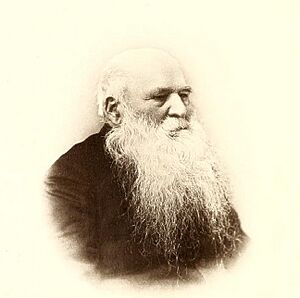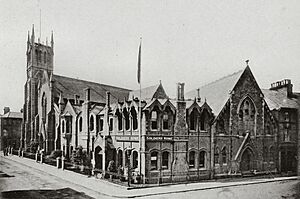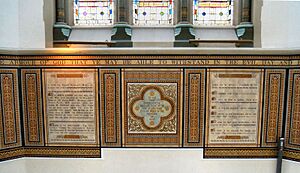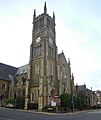Wesleyan Church, Aldershot facts for kids
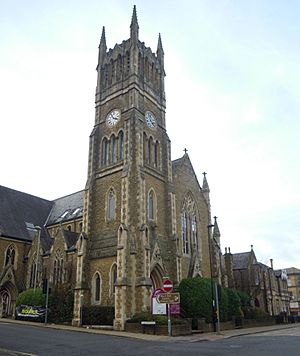
The Wesleyan Church in Aldershot, Hampshire, England, was once a busy Methodist church. It closed its doors in 1988. This beautiful building is now a Grade II* listed building, which means it's a very important historic building. Today, it's used for offices, a dental studio, and even a gym. You can find it at the corner of Grosvenor Road and Queens Road in Aldershot.
Contents
How Methodism Started in Aldershot
Methodism first came to Aldershot in 1856. A minister named Rev Dr William Harris Rule started working with soldiers there. He helped open an iron chapel in Church Street in 1857. This was a special place for soldiers to worship.
At first, Methodism wasn't officially recognized by the Army. Some local church leaders didn't like it. But Dr. Rule had support from important people like Lieut-General William Knollys. By 1862, Methodism was accepted, and the work continued.
A New Church for a Growing Town
Over time, the old chapel became hard to reach because of new walls built around the army camp. So, another minister, Rev Richard Watson Allen, found a new, bigger spot. This new location was right in the middle of Aldershot, close to the army barracks.
People worked hard to raise money for a new, grand church. Construction started in 1874. Next to the church, a "Soldiers' Home" was built. This home had a lecture room, library, and a place for refreshments. It opened in 1875, offering a welcoming space for soldiers.
The main church building was finished in 1877. It was a very impressive building with a tall 100-foot tower. It could seat 1,150 people! The whole project cost about £10,000, which was a huge amount of money back then.
Design and Special Features
The church was designed by William Willmer Pocock. It was built using local sandstone and Bath stone, with a slate roof. The style is called Gothic Revival, which means it looks like old medieval churches. It has features from different periods of English Gothic design.
The church has a main hall called a nave, with side sections called aisles. It also has transepts (arms of the cross shape) and a chancel (the area near the altar). The large tower at the front is a well-known landmark in Aldershot. You can see it from far away!
Inside the Church
An organ was added to the church in 1906. Later, after 1932, choir stalls and a lectern (a stand for reading) were put in. This happened when a smaller Methodist chapel closed, and its members joined the Wesleyan Church.
The church's tower clock was installed in 1922. It was a memorial to Rev. Edward Pearce Lowry, a chaplain who served the Aldershot army base for many years.
Inside, the nave is supported by strong cast iron columns. Behind where the altar used to be, there's a beautiful mosaic and tile artwork called a reredos. This artwork showed the Ten Commandments and the Lord's Prayer. It was put there to remember Frances Penelope Wharton Middleton, whose father and husband both fought in the famous Battle of Waterloo in 1815.
The Methodist Union and What Happened Next
The Wesleyan Church and its Soldiers' Home served the Aldershot community for over 100 years. In 1932, different Methodist groups in Britain joined together in something called the Methodist Union. This meant the Aldershot church became part of a larger Methodist family.
For a while, the town had two main Methodist churches: the Wesleyan Church on Grosvenor Road and another chapel on Ash Road. The Ash Road chapel closed in 1958 because it was no longer big enough. A new building, called Stone Street, was built to replace it.
In 1988, the Wesleyan Church building on Grosvenor Road was sold. The money from the sale was £500,000. The church members then joined other Methodist churches in the area, including the Stone Street church, which later became Aldershot Methodist Church.
After being sold, the old Wesleyan Church building was changed inside and out. It was turned into the offices, dental surgery, and gym you see today. The architects who did the conversion even won an award for their work in 1992!
Images for kids


